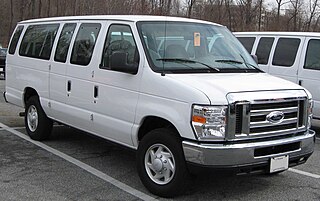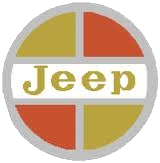
Jeep is an American automobile marque, now owned by multi-national corporation Stellantis. Jeep has been part of Chrysler since 1987, when Chrysler acquired the Jeep brand, along with remaining assets, from its previous owner American Motors Corporation (AMC).

The Ford E-Series is a range of full-size vans manufactured and marketed by the Ford Motor Company. Introduced for model year 1961 as the replacement for the Ford F-Series panel van, the E-Series line is currently in its fourth generation.

The Jeep CJ models are a series and a range of small, open-bodied off-road vehicles and compact pickup trucks, built and sold by several successive incarnations of the Jeep automobile marque from 1945 to 1986. The 1945 Willys Jeep was the world's first mass-produced civilian four-wheel drive car.

The Willys F4-134 Hurricane was an inline-4 piston engine and powered the famous Jeep CJ in the CJ-3B, CJ-5, and CJ-6 models. It was also used in the Willys 473 and 475 pickups, wagons, and sedan deliveries. It replaced the Willys Go Devil engine that was used in the MB Jeep and other early Jeep-based models like the Jeepster. This engine was also built by Mitsubishi for their license-built Jeep, as well as other applications.

The Ford Excursion is a heavy duty, full-sized SUV that was produced by Ford. The longest and heaviest SUV ever to enter mass production, the Excursion was marketed as a direct competitor of the 2500-series Chevrolet Suburban/GMC Yukon XL. Introduced on September 30, 1999 for the 2000 model year, a single generation was produced through the 2005 model year.

The Jeep Gladiator, Jeep Pickup or J-series is a series of full-size pickup trucks based on the large Jeep SJ (Wagoneer) platform, which was built and sold under numerous marques from 1962 until 1988. The Jeep Gladiator/Pickup design is noteworthy for remaining in production for more than 26 years on a single automobile platform generation. The Gladiator was the basis of the first post-war U.S. Army trucks designed to be civilian vehicles and adapted to military use. Numerous versions of the Jeep pickup were built in other markets, including Mexico by Vehículos Automotores Mexicanos (VAM) and Argentina by Industrias Kaiser Argentina (IKA).

Kaiser Jeep was the result of the 1953 merger of Kaiser Motors, an independent passenger car maker based in Willow Run, Michigan, with the Toledo, Ohio-based Willys-Overland Company.

The Jeepster Commando is an automobile which was first produced by Kaiser Jeep in 1966 to compete with the International Scout, Toyota Land Cruiser and Ford Bronco. Four different models were available: a pickup truck, convertible, roadster and wagon. The Jeepster remained in production after American Motors Corporation (AMC) bought the Jeep line from Kaiser in 1970. After AMC's acquisition, the Jeepster Commando C101 steadily grew in popularity. In 1972, AMC shortened the vehicle's name to Commando C104, extended the wheelbase to 104", and changed the front-end design to accept the AMC I6 and V8 304ci, similar to the Ford Bronco. The new configuration, formerly an AMC best seller, quickly caused the line to drop in popularity and was taken out of production in 1973; it was replaced with the full size Cherokee. The Jeepster is an ancestor of the modern Jeep family produced by Chrysler.

The Chevrolet (S-10) Blazer and its badge engineered GMC (S-15) Jimmy counterpart are compact/mid-size SUVs manufactured and marketed by Chevrolet and GMC from the 1983 through 2005 model years, over two generations – until the early 1990s alongside these brands' full-size SUVs with near identical nameplates, but lacking removable hardtops. From the 1992 model year, GMC's big Jimmy had become the 'Yukon', and so the S-15 prefix was dropped on the smaller GMC Jimmy. Starting with the 1995 second generation, the large Blazer was rebranded as the Chevrolet Tahoe, and these mid-size SUVs were simply launched as the 'all-new Chevrolet Blazer'.

The D/W series is a line of pickup trucks that was sold by Dodge from October 1960 to September 30, 1993. The same basic design was retained until the October 1993 introduction of a completely redesigned Ram. The D/W series shared its AD platform with the Dodge Ramcharger/Plymouth Trail Duster twins. 4x2 models were designated D, while 4x4 models were designated W.

The Ford Super Duty is a series of heavy-duty pickup trucks produced by the Ford Motor Company since the 1999 model year. Slotted above the consumer-oriented Ford F-150, the Super Duty trucks are an expansion of the Ford F-Series range, from the F-250 to the F-550. Rather than adapting lighter-duty trucks for heavier use, Super Duty trucks have been designed as a dedicated variant of the Ford F-Series, including pickup trucks and chassis-cab vehicles; the Ford F-450 is the largest pickup truck offered for sale in North America.

The Isuzu Faster is a pickup truck that was manufactured and marketed by Isuzu between 1972 and 2002 over three generations. The Faster was succeeded worldwide by Isuzu D-Max, except in North America.

Willys was a brand name used by Willys–Overland Motors, an American automobile company, founded by John North Willys. It was best known for its design and production of World War II era and later military jeeps (MBs), as well as civilian versions, and branding the 'jeep' military slang-word into the '(Universal) Jeep' marque.
The Rastrojero is a small utility pickup truck with a capacity of half-ton designed by Raúl Gómez and built by the Argentine government-owned airplane manufacturer IAME from 1952 to 1980. It owes its name to its purpose of being driven on crop residue (rastrojos). Over 33,000 of these trucks were manufactured.

The Chevrolet Van or Chevy Van is a range of vans that was manufactured by General Motors from the 1964 to 1996 model years. Introduced as the successor for the rear-engine Corvair Corvan/Greenbrier, the model line also replaced the panel van configuration of the Chevrolet Suburban. The vehicle was sold both in passenger van and cargo van configurations as well as a cutaway van chassis that served as the basis for a variety of custom applications.
Vehículos Industriales y Agrícolas, S.A. was a Spanish automobile company, a division of parent company Construcciones y Auxiliares de Ferrocariles (CAF).

In 1939 Dodge presented a completely new designed line of pickups and trucks. Formally the T series for 1939, V series for 1940, and the W series from 1941 through 1947, the trucks became mostly known as the Dodge Job-Rated trucks.
The Toyota FA and BA were heavy duty trucks introduced in February 1954. They were facelifted versions of the earlier BX/FX trucks, retaining those trucks Type B and Type F six-cylinder petrol engines. The first letter in the model name indicates the engine family fitted; in 1957 the Type D diesel engine was introduced in a model known as the DA. The second letter indicated the size of the truck, with shorter medium duty versions being coded BC/FC/DC. A second letter "B" was used on bus versions of this chassis. A second generation FA/DA was introduced in 1964 and was built in Japan until 1980, when Hino replaced Toyota's heavier truck lines entirely. The DA, however, was also built in numerous other countries and manufacture continued into the first decade of the 21st century.




















